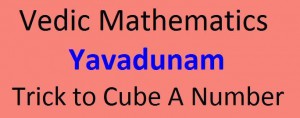Yavadunam - Shorcut to find Cube of a Number Specific Condition Required for Yavadunam sutra: Number need to be closer to power of 10.(10, 100, 1000, etc). Examples: (Self Explanatory) Lets see examples for how to find Cube of a Number using Yavadunam in Vedic Mathematics. … [Read more...]
#@1 How to find cube of a number using Anurupyena in Vedic Mathematics
Anurupyena Sutra Anurupyena means Proportionality Prerequisites: Before starting with shortcut to find cube of a number in Vedic Mathematics below concepts are required. Vinculum Technique. Nikhilam method of Multiplication Nikhilam method of Division No Specific Condition Required Formula: Lets see Vedic Maths tricks for Cube of a 2 digit number using Anurupyena Sutra: Also Check => More Sutras of Vedic Mathematics to calculate cube of a number (a+b)3 = a3 + 3a2b + 3ab2 + b3 Examples: Interesting Fact: 1st row will always be in Geometric Progression. (a3, a2b, ab2, b3) … [Read more...]
How to Divide in 1 line In Vedic mathematics using Ekadhikena Purvena
Ekadhikena Purvena - Divide numbers in one line. Shortcut Division when Divisor Ending with 9 Sutra Used: Ekadhikena Purvena (1 more than the previous)(see more in Squares topic). Examples: 1/19 I: Method 1 (L --> R): For the denominator 19, the purva (previous) is 1. Hence Ekadhikena purva (one more than the previous) is 1 + 1 = 2. Now we will be using 2 for Division purpose. Write 1/19 as 1/20 (but remember they are not equal : )) Steps: Divide 1 by 2 which gives Quotient as 0(written with yellow) and Remainder as 1 (written on left side of Quotient with White) Now divide 10 by 2 which gives Quotient as 5(written with yellow) and Remainder as 0 (written on left side of Quotient with White) Now divide 05 by 2 which gives Quotient as 2(written with yellow) and Remainder as 1 (written on left side of Quotient with White) Similarly go on carrying this process till you find same pair of Quotient and Remainder is obtained. At the end we get 01, on dividing it by 2 we get Quotient as 0 and Remainder as 1. So that means same series (from blue dot to blue dot) will keep on repeating. So the series written in yellow color is final answer. II: Method 2 (R--> L): Here as well Ekadhikena Purvena is 2. BUT here we use 2 for multiplication purpose. Steps: (From R --> L) We start by putting 1. Multiply it 2 which gives 2. Now Multiply 2 by 2 which gives 4. Now Multiply 4 by 2 which gives 8. Now Multiply 8 by 2 which gives 16. Carry forward 1 (written in yellow). Now multipliy 6 by 2 and add the carry forward to it, gives 13. Carry Forward 1. Similarly go on carrying this process till you find same pair of Quotient and Remainder is obtained. Finally 0 will be obtained with carry forward 1. Multiplying 0 with 2 and adding carry forward gives 1 which repeats the series. So the series written in yellow color is final answer. III: Method 3 (More Shorter): Any of the above 2 methods are carried out till a certain criteria … [Read more...]
Special Types
These are special types of divisions when we have particular numbers as the last digit of Divisor. For simplicity purpose, I have classified them in 3 groups. Kevalaih Saptakam Gunyat & Vestanas Sesani Ankena Caramena Ekadhikena Purvena … [Read more...]
Direct -Flag Method: Shortcut Method to Divide Numbers using Vedic Mathematics
Flag Method (Direct Division Method )- Division in Vedic Mathematics Direct Flag Method is a General Method of Vedic Mathematics is used to carry division of ANY types of numbers. Prerequisites: In this post you will see Flag Method Division of Vedic mathematics. Before starting, It is very important to know Vinculum & playing with Quotients & Remainders. Examples: Also Read More Division Sutras in Vedic Mathematics Single Digit Flag #1. 1234/12 Dividend = 1234 and Divisor = 12. Split divisor (12) in 2 parts (1 and 2) where division will be carried using ONLY 1(new divisor) and 2 is called as flag. As flag is single digit, Split dividend in 2 parts such that 2nd part will have same number as that of flag i.e. 1 digit. Process (see the example for each step): Division of 1 by 1 (Q=1 and R= 0). Write Q=1 and carry forward the R=0(written in white under and between 1&2). Multiply the new Q(1) with the flag(2) and subtract this product from 02 = 0 and divide this subtraction by 1. It gives Q= 0 and R= 0(Carry forward R=0). (i.e. Multiply, Subtract, Divide) Follow same above process, So multiply new Q(0) with flag(2) and subtract this product from 03 = 3 and divide this subtraction by 1. It gives Q= 3 and R= 0(Carry forward R=0). For remainder we carry same process EXCEPT we don’t divide. (i.e. Multiply, Subtract) So multiply new Q(3) with flag(2) and subtract this product from 04 = -2. As we get negative subtraction, we reduce the quotient by 1 and increase the remainder by the 1st multiplier of new multiplier (1X1 =1). So new Q = 2 and new R =1. (Refer Topic How to Play with Quotient and Remainder). We carry this method till we don’t have negative subtraction. Now Multiply the new Q(2) with the flag(2) and subtract this product from 14 = 10(positive) and put it down as it is. So final answer: Quotient = 102 and Remainder = 10 (Remainder should always < Divisor| (How to Play with Quotient and Remainder). More … [Read more...]


